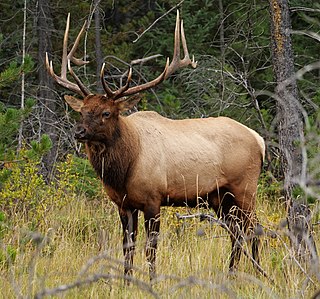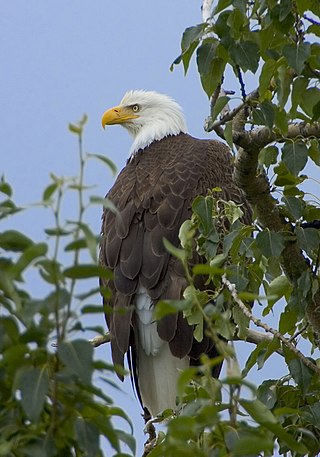Related Research Articles

The chum salmon, also known as dog salmon or keta salmon, is a species of anadromous salmonid fish from the genus Oncorhynchus native to the coastal rivers of the North Pacific and the Beringian Arctic, and is often marketed under the trade name silverbrite salmon in North America. The English name "chum salmon" comes from the Chinook Jargon term tsəm, meaning "spotted" or "marked"; while keta in the scientific name comes from Russian, which in turn comes from the Evenki language of Eastern Siberia. The term 'Dog Salmon' is most commonly used in Alaska and refers to the Salmon whose flesh Alaskans use to feed their dogs.
Besnoitia bennetti is a parasite that can cause besnoitiosis infections in donkeys. The range of this organism ranges from Africa to the United States. B. bennettii shares similar characteristics with Toxoplasma, Neospora, and Sarcocystis genera. Lab work on B. bennetti is conducted at biosafety level 1.
Besnoitia is a genus of apicomplexan parasites.
Besnoitia besnoiti is an apicomplexan protozoan parasite, closely related to Toxoplasma gondii and Neospora caninum,. It is part of a larger genus Besnoiti affecting multiple animal species, but Besnoita besnoiti, can affect livestock. and more specifically cattle as intermediate host, although some specific antibodies have been found in roe deer and red deer.
Besnoitia tarandi is a species of single-celled parasites that afflicts reindeer and causes besnoitiosis.

The wood bison or mountain bison, is a distinct northern subspecies or ecotype of the American bison. Its original range included much of the boreal forest regions of Alaska, Yukon, western Northwest Territories, northeastern British Columbia, northern Alberta, and northwestern Saskatchewan.

Basidiobolus ranarum is a filamentous fungus with worldwide distribution. The fungus was first isolated by Eidam in 1886. It can saprophytically live in the intestines of mainly cold-blooded vertebrates and on decaying fruits and soil. The fungus prefers glucose as a carbon source and grows rapidly at room temperature. Basidiobolus ranarum is also known as a cause of subcutaneous zygomycosis, usually causing granulomatous infections on a host's limbs. Infections are generally geographically limited to tropical and subtropical regions such as East and West Africa. Subcutaneous zygomycosis caused by B. ranarum is a rare disease and predominantly affects children and males. Common subcutaneous zygomycosis shows characteristic features and is relatively easy to be diagnosed; while, certain rare cases might show non-specific clinical features that might pose a difficulty on its identification. Although disease caused by this fungus is known to resolve spontaneously on its own, there are a number of treatments available.

Aeromonas hydrophila is a heterotrophic, Gram-negative, rod-shaped bacterium mainly found in areas with a warm climate. This bacterium can be found in fresh or brackish water. It can survive in aerobic and anaerobic environments, and can digest materials such as gelatin and hemoglobin. A. hydrophila was isolated from humans and animals in the 1950s. It is the best known of the species of Aeromonas. It is resistant to most common antibiotics and cold temperatures and is oxidase- and indole-positive. Aeromonas hydrophila also has a symbiotic relationship as gut flora inside of certain leeches, such as Hirudo medicinalis.

The elk, or wapiti, is the second largest species within the deer family, Cervidae, and one of the largest terrestrial mammals in its native range of North America and Central and East Asia. The word "elk" originally referred to the European variety of the moose, Alces alces, but was transferred to Cervus canadensis by North American colonists.

The fauna of the United States of America is all the animals living in the Continental United States and its surrounding seas and islands, the Hawaiian Archipelago, Alaska in the Arctic, and several island-territories in the Pacific and in the Caribbean. The U.S. has many endemic species found nowhere else on Earth. With most of the North American continent, the U.S. lies in the Nearctic, Neotropic, and Oceanic faunistic realms, and shares a great deal of its flora and fauna with the rest of the American supercontinent.
The wildlife of Alaska is both diverse and abundant. The Alaskan Peninsula provides an important habitat for fish, mammals, reptiles, and birds. At the top of the food chain are the bears. Alaska contains about 70% of the total North American brown bear population and the majority of the grizzly bears, as well as black bears and Kodiak bears. In winter, polar bears can be found in the Kuskokwim Delta, St. Matthew Island, and at the southernmost portion of St. Lawrence Island. Other major mammals include moose and caribou, bison, wolves and wolverines, foxes, otters and beavers. Fish species are extensive, including: salmon, graylings, char, rainbow and lake trout, northern pike, halibut, pollock, and burbot. The bird population consists of hundreds of species, including: bald eagles, owls, falcons, ravens, ducks, geese, swans, and the passerines. Sea lions, seals, sea otters, and migratory whales are often found close to shore and in offshore waters. The Alaskan waters are home to two species of turtles, the leatherback sea turtle and the green sea turtle. Alaska has two species of frogs, the Columbia spotted frog and wood frog, plus two introduced species, the Pacific tree frog and the red-legged frog. The only species of toad in Alaska is the western toad. There are over 3,000 recorded species of marine macroinvertebrates inhabiting the marine waters, the most common being the various species of shrimp, crab, lobster, and sponge.

Henneguya zschokkei or Henneguya salminicola is a species of a myxosporean endoparasite. It afflicts several salmon in the genera Oncorhynchus and Salmo,where it causes milky flesh or tapioca disease. H. zschokkei does not require oxygen to survive and is notable for being one of the few multicellular organisms in the animal kingdom to rely on an exclusively anaerobic metabolism. It is also notable for its lack of both mitochondria and mitochondrial DNA.
Tropical Asia refers to the entirety of the areas in Asia with a tropical climate. These areas are of geographic and economic importance due to their natural resources and biodiversity, which include many species of agricultural value. There are 16 countries in tropical Asia, ranging in size from around 610 square kilometres (Singapore) to 3,000,000 km2 (1,200,000 sq mi) (India). The total population as of 2006 was 1.6 billion, predominantly rural, and projected to reach 2.4 billion by 2025. Climate in tropical Asia is subject to seasonal weather patterns with the two monsoons and the amount of tropical cyclones in the three core areas of cyclogenesis. Stressors on the environment include growing urbanization, land industrialization, economic development, land degradation, environmental issues, and increased pollution, all of which are contributing to changes in climate.
Mycoplasma ovipneumoniae is a species of Mycoplasma bacteria that most commonly inhabits and affects ovine animals, first described in 1972. M. ovipneumoniae contributes to harmful pneumonia in sheep and goats. The duration and severity of M. ovipneumoniae varies from region to region.

The wildlife of Somalia includes the flora and fauna of Somalia, which is extremely diverse due to the country's location between the temperate and the tropical zones. Somalia has a long coastline, bordered by the Indian Ocean in the east and Red Sea in the north. The northwestern and central parts of the country are arid, or very dry. The southern and northeastern regions are semi-arid, receiving slightly more rainfall than the central and northwest regions. The coastal region is more humid due to its proximity to the ocean. Somalia is home to over 727 species of birds and boasts over 177 species of mammals.

The Alaskan hare, also known as the tundra hare, is a species of mammal in the family Leporidae. They do not dig burrows and are found in the open tundra of western Alaska and the Alaska Peninsula in the United States. They are solitary for most of the year except during mating season, when they produce a single litter of up to eight young. Predators include birds of prey, lynx, mustelids and wolves, among other animals, as well as humans.

Ecotourism in the United States is commonly practiced in protected areas such as national parks and nature reserves. The principles and behaviors of ecotourism are slowly becoming more widespread in the United States; for example, hotels in some regions strive to be more sustainable.

The Alaska moose, or Alaskan moose in Alaska, or giant moose and Yukon moose in Canada, is a subspecies of moose that ranges from Alaska to western Yukon. The Alaska moose is the largest subspecies of moose. Alaska moose inhabit boreal forests and mixed deciduous forests throughout most of Alaska and most of Western Yukon. Like all moose subspecies, the Alaska moose is usually solitary but sometimes will form small herds. Typically, they only come into contact with other moose for mating or competition for mates. Males and females select different home ranges during different seasons. This leads to spatial segregation throughout much of the year. While males and females are spatially separate the habitat that they occupy is not significantly different. During mating season, in autumn and winter, male Alaska moose become very aggressive and prone to attacking when startled.

Yup'ik cuisine refers to the Inuit and Yup'ik style traditional subsistence food and cuisine of the Yup'ik people from the western and southwestern Alaska. Also known as Cup'ik cuisine for the Chevak Cup'ik dialect speaking Eskimos of Chevak and Cup'ig cuisine for the Nunivak Cup'ig dialect speaking Eskimos of Nunivak Island. This cuisine is traditionally based on meat from fish, birds, sea and land mammals, and normally contains high levels of protein. Subsistence foods are generally considered by many to be nutritionally superior superfoods. Yup’ik diet is different from Alaskan Inupiat, Canadian Inuit, and Greenlandic diets. Fish as food are primary food for Yup'ik Eskimos. Both food and fish called neqa in Yup'ik. Food preparation techniques are fermentation and cooking, also uncooked raw. Cooking methods are baking, roasting, barbecuing, frying, smoking, boiling, and steaming. Food preservation methods are mostly drying and less often frozen. Dried fish is usually eaten with seal oil. The ulu or fan-shaped knife is used for cutting up fish, meat, food, and such.
References
- 1 2 "Besnoitiosis: Introduction". Merck Veterinary Manual.
- 1 2 "Besnoitiosis". The Free Dictionary.
- ↑ "Besnoitiosis in Alaska's Species, Alaska Department of Fish and Game". Alaska Department of Fish and Game. Retrieved 2025-01-21.